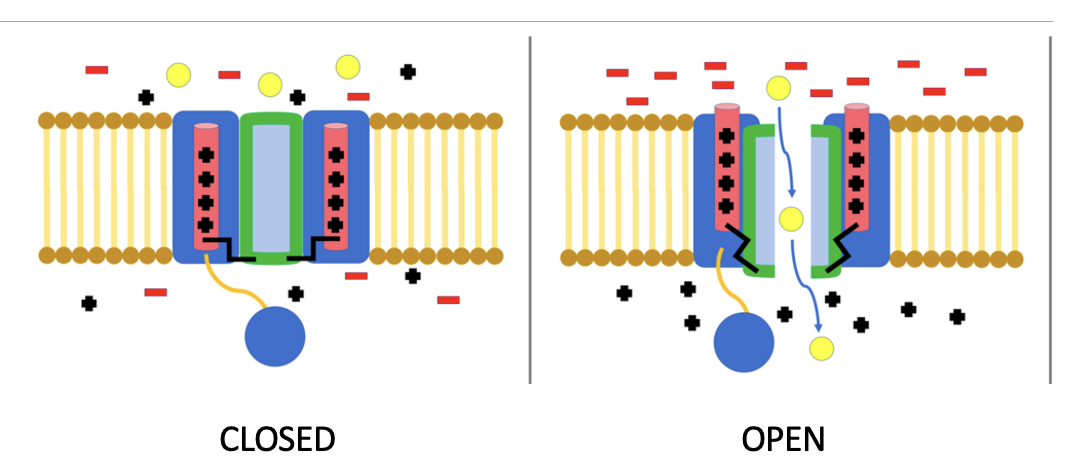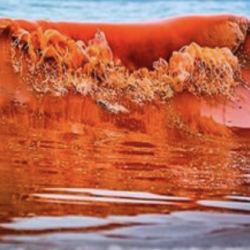If you’re planning to vacation in Florida, it better be on the East coast. Because along the Gulf there’s an enormous red tide, which contains a potent neurotoxin that’s killed millions of fish, while also making a bunch of swimmers sick. And in case that's not enough, be prepared for 5,000 miles of sargassum, which is expected to wash up. We have that for you, AND a Dreaded Neurochemistry Lesson From Hell!
For those of you who picked Florida's Gulf Coast rather than the Atlantic for spring break or vacation, this article will be of little consolation. That is unless you prefer sitting in your room being educated about tortured by a lesson on voltage-gated sodium ion channels. This is unlikely.
But knowledge is knowledge, and the reason you're not in the 78o water on Longboat Key just happens to be because your voltage-gated sodium ion channels are not fond of neurotoxins produced by Karenia brevis, a type of algae naturally present in the Gulf (1). The algae are what causes the dreaded "red tide," which is pretty much an annual occurrence. But this one seems like it will be much worse than usual, even though peak season is still months away.
How bad is red tide?
Although swimming in a red tide is usually not dangerous for most people, it can still produce some pretty nasty symptoms, especially irritation in the eyes, nose, throat, and lungs. It can also cause asthma attacks. But those who are on the fence about swimming in the stuff may be turned off by the 13.5 tons of dead fish that washed up on Fort Myers Beach alone (and this is going on up and down the Gulf for hundreds of miles). Fish and other marine wildlife are especially sensitive to brevetoxin (2), a neurotoxic chemical produced by Karenia brevis algae as a defense system. This is hardly unique; many life forms that may be on the menu for something else develop some sort of a defense system to keep them from being devoured. A number of marine animals and microorganisms are especially good at making neurotoxins.
How do they work?
Well, it's time to dust off Steve and Irving, who briefly went to Fort Lauderdale but upon observing spring break, they decided hell was more pleasant and returned quite early. This means that they will be available for...

Steve (left) and Irving are crankier than usual, having cut short their Florida vacation. Strangely, they continue to wear the apparel they purchased in Fort Lauderdale. Free image: Vector Portal
There is just about nothing more complicated than electrophysiology, so I'm going to have to make it really simple. If you don't like it, see Steve and Irving.
Electrical signals are critical for all forms of life that have nerves. Nerves are the wires that carry signals (electric impulses) from the brain to other parts of the body when triggered by a stimulus, such as a painful injury. They are not meant to fire all the time (this is what happens when you're exposed to Sarin or VX gas). Instead, they transmit signals interrupted by tiny switches called ion channels. Ion channels are designed to open very rapidly and close to start and stop an impulse. The switches control the flow of ions across cell membranes and maintain the correct number and kind of ions (Na+, K+, Ca++, and Cl-) that control whether the cell "fires" or not. It should be intuitively obvious that since ion channels play an essential role in maintaining timing, they are mostly found in the heart and central nervous system, where timing is essential. Brevetoxin screws up (see Figure 2) the movement of sodium ions in and out of cells, which (to put it technically) makes a gigantic mess. The following two figures should illustrate (in crude form) how ion channels work.

Figure 1. A simple representation of a voltage-gated ion channel. (Left) When closed, ions cannot migrate in or out of the cell. (Right) When open, ions (but only the right ones) can move into and out of cells resulting in a difference in the charge on both the inside and outside. It is this change in the balance of ions (also called electric potential) that chemically transmits an impulse along the nerve. Image: Wikipedia Commons.
Why is brevetoxin a neurotoxin?
Brevetoxin binds to sodium ion channels, preventing the movement of ions in and out of the nerve cell. This stops the cell from functioning properly. (Figure 2)

Figure 2. (Left) The chemical structure of brevetoxin - an absolute monster of a molecule. (Center) A representation of an ion channel viewed from above. The white "donut hole" is the channel in the cell membrane, which, when open, allows the migration of ions to and from the cell. (Left) A pictorial representation of brevetoxin (yellow box) binding to an interior portion of the channel, which blocks the movement of ions and short-circuits" the nerve. This binding is responsible for the potent toxicity of brevetoxin and other marine toxins that work in a similar manner.
Source: "Functional characterization of brevetoxin-induced neurotoxicity in cortical neurons using membrane potential-sensitive fluorescent probes and cell signaling assays." Jennifer Hill-Hoffman Peterson, 2003.
But it gets worse
What's worse than trying to take a vacation in poisonous water surrounded by tons of dead fish? Maybe this is:

Sargassum on a "beach." Image: Wikimedia Commons.
If that teensy bunch of seaweed above looks disgusting, it is nothing compared to what is out in the Gulf waiting to wash ashore in the Gulf (3). It is called a "seaweed blob." The name does not do it justice; the damn thing is 5,000 miles long – twice the length of the US. It has already made it to beaches along the Gulf coast, the Florida Keys, and part of the Caribbean and Mexico uninhabitable. Yuck!
What to do?
That's simple. Pick a different beach. On the East coast

Lauderdale by the Sea. Free image: Flickr
NOTE:
(1) While red tide naturally occurs in the Gulf, enormous blooms like this are attributed to runoff from lawns, etc. By all means, let's build even more condos down there.
(2) There are actually a number of brevetoxins I have chosen to show only brevetoxin A. You don't want to see the rest.
(3) The Gulf is warmer than the Atlantic in the summer and cooled in the winter. This, plus the fact that the Gulf is much calmer than the Atlantic plays a part in algae blooms.

